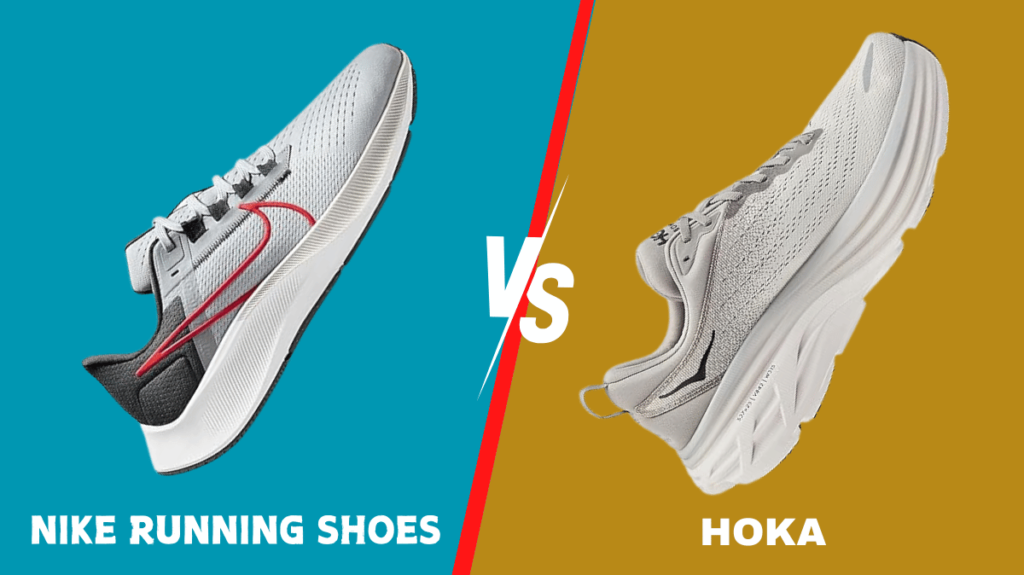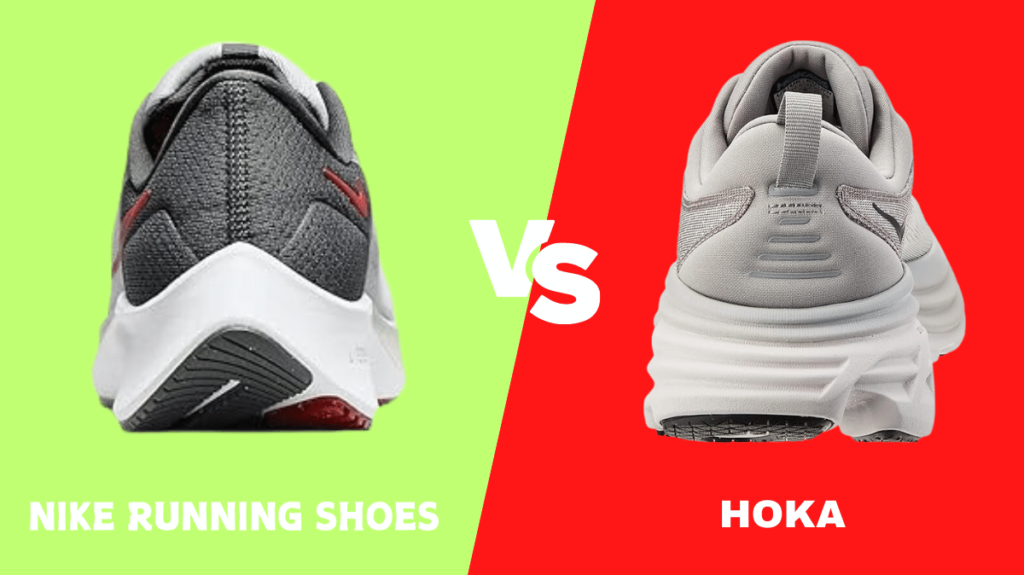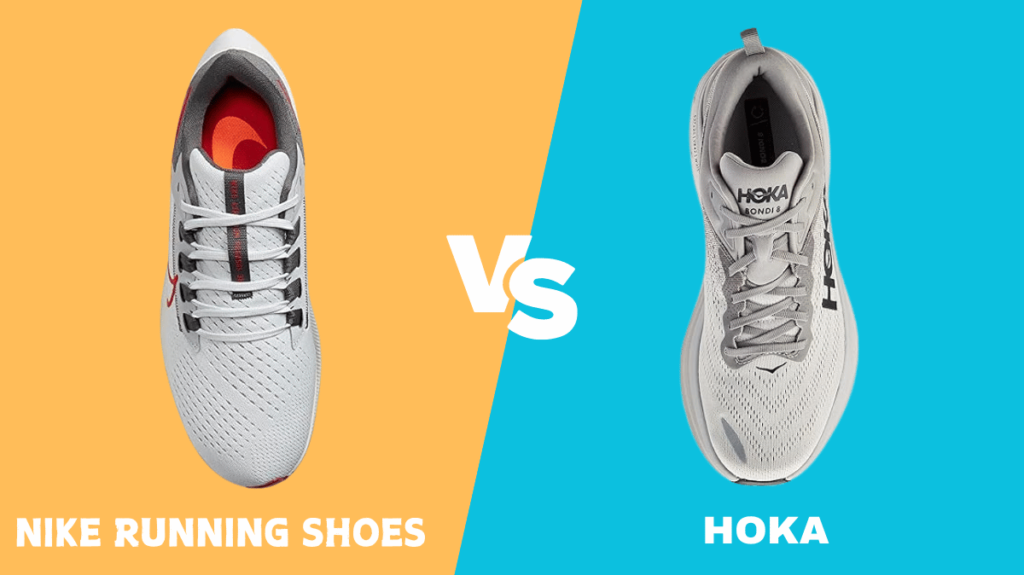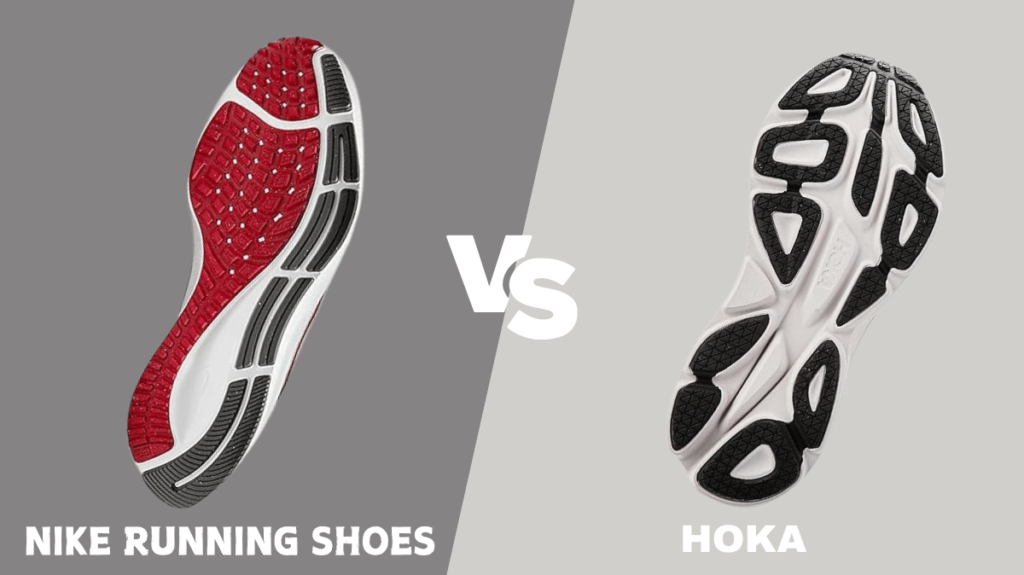Physical Address
304 North Cardinal St.
Dorchester Center, MA 02124
Physical Address
304 North Cardinal St.
Dorchester Center, MA 02124
Choosing the right running shoe can make a big difference in your comfort and performance. Two top brands in the market are Nike and Hoka. In this guide, we’ll explore these brands in detail to help you decide which one is best for you.

| Feature | Nike Running Shoes | Hoka Running Shoes |
| Brand Philosophy | Emphasis on innovation, performance, and style. | Focus on maximum cushioning, comfort, and a smooth ride. |
| Cushioning | Often uses Zoom Air, React Foam, and other proprietary technologies for responsive cushioning. | Known for thick, plush cushioning with materials like EVA and Meta-Rocker for a smooth transition. |
| Weight | Generally lightweight with a focus on speed and agility. | Generally heavier due to extra cushioning, but designed to feel lightweight while running. |
| Traction | High-performance outsoles with various grip patterns for different terrains. | Aggressive outsoles with deep lugs for excellent traction, especially on trails. |
| Arch Support | Offers various models with different levels of arch support, including neutral and stability options. | Typically features a standard level of support with a focus on cushioning and comfort. |
| Heel-to-Toe Drop | Varies by model, often ranges from 4mm to 10mm. | Generally high, often ranging from 4mm to 6mm, contributing to the distinctive “Hoka feel.” |
| Design & Aesthetics | Stylish, often incorporates the latest fashion trends and collaborations. | Bulky but functional, focused more on performance than aesthetics. |
| Fit & Sizing | Tends to run true to size with various width options. | Typically has a roomy fit, accommodating wider feet and providing extra comfort. |
| Durability | Generally durable, with different models designed for various distances and terrains. | Known for durability, especially in their trail models, with robust materials for long-lasting wear. |
| Price Range | Mid to high-end, with a wide range of prices depending on the model and technology. | Mid to high-end, with prices reflecting the advanced cushioning technology and materials. |
| Target Users | Suitable for a variety of runners, from casual joggers to competitive athletes. | Ideal for long-distance runners and those seeking maximum comfort, especially for recovery runs and trail running. |
Nike is famous for making comfortable running shoes. They use technologies like Zoom Air and React foam to make each step feel cushioned and smooth. Nike shoes often feel lightweight, which helps reduce fatigue during long runs.
Pros:
Cons:
Hoka is known for its thick, plush cushioning. Their shoes are designed to give you a very soft and comfortable ride. Hoka’s Meta-Rocker technology helps you move smoothly from heel to toe.
Pros:
Cons:
| Feature | Nike Running Shoes | Hoka Running Shoes |
| Cushioning | Responsive | Maximalist |
| Shock Absorption | Good | Excellent |
| Weight | Lightweight | Bulkier |

Nike is well-known for its stylish designs. Their running shoes come in a variety of colors and patterns, making them a favorite for those who want their gear to look as good as it performs.
Pros:
Cons:
Hoka shoes focus more on function than style. They have a distinctive look with thick soles and a wide base, which might not be as fashionable but are designed to be very practical.
Pros:
Cons:
| Feature | Nike Running Shoes | Hoka Running Shoes |
| Aesthetics | Trendy | Functional |
| Color Options | Wide range | Limited range |
| Design Focus | Sleek | Comfort-oriented |
Nike generally offers consistent sizing, though some models may run slightly small or large. Checking their size guide or trying on different models can help you find the best fit.
Hoka’s sizing is usually consistent, but it’s often recommended to go half a size up, especially for wider feet. This can help ensure a better fit.
| Feature | Nike Running Shoes | Hoka Running Shoes |
| Sizing Chart | Consistent | Generally consistent |
| Fit Variation | Minor variations | Slight model-based |
| Recommendation | Check size guide | Consider sizing up |
Nike is a well-established brand with a long history of innovation in sportswear. They are known for their advanced technology and strong marketing.
Strengths:
Weaknesses:
Hoka is newer but has built a strong reputation for comfort. They are especially favored by long-distance runners and those with joint concerns.
Strengths:
Weaknesses:
| Feature | Nike | Hoka |
| Market Presence | Established | Growing |
| Innovation | High | Specialized |
| Popularity | Widely recognized | Niche popularity |

Nike shoes often have mesh uppers that allow for good airflow. This helps keep your feet cool and dry during runs.
Pros:
Cons:
Hoka also uses breathable materials in their shoes, which helps with ventilation. Their shoes are designed to keep your feet comfortable in warm conditions.
Pros:
Cons:
| Feature | Nike Running Shoes | Hoka Running Shoes |
| Ventilation | Good | Effective |
| Materials | Mesh uppers | Mesh and knit |
| Suitability | Warm and moderate climates | Warm climates |
Nike’s running shoes are generally durable, especially higher-end models with reinforced outsoles. However, lower-end models might wear out faster.
Pros:
Cons:
Hoka shoes are known for their durability, particularly those made for trail running. Their high-quality materials usually last a long time, though the cushioning can compress over time.
Pros:
Cons:
| Feature | Nike Running Shoes | Hoka Running Shoes |
| Material Quality | Generally high | High |
| Wear and Tear | Variable by model | Good, with some compression |
| Longevity | Varies | Good for long-term |
Nike offers a variety of fits to accommodate different foot shapes. They provide good arch and ankle support, with technologies like Flyknit and Flywire enhancing fit and support.
Pros:
Cons:
Hoka shoes are known for their secure fit and plush cushioning. They provide excellent arch support and stability, especially for long runs.
Pros:
Cons:
| Feature | Nike Running Shoes | Hoka Running Shoes |
| Arch Support | Good | Excellent |
| Ankle Support | Good | Excellent |
| Overall Fit | Varied by model | Secure and plush |
Nike’s running shoes are typically on the higher end of the price range, but sales and discounts can make them more affordable.
Price Range: $80 – $250
Hoka’s prices are similar to Nike’s, though they often provide good value in terms of cushioning and comfort.
Price Range: $120 – $250
| Feature | Nike Running Shoes | Hoka Running Shoes |
| Price Range | $80 – $250 | $120 – $250 |
| Value for Money | Depends on model | Generally good |
| Discounts | Frequent | Less frequent |

Nike is well-reviewed for its innovative technology and stylish designs. Many users praise their shoes for comfort and performance, though some have noted issues with durability in certain models.
Pros:
Cons:
Hoka receives high marks for its cushioning and comfort. Runners often commend their shoes for reducing impact and providing a smooth ride, though some find the design less appealing.
Pros:
Cons:
Both Nike and Hoka offer great running shoes, but they cater to different needs. Nike is perfect for those looking for stylish, performance-focused shoes, while Hoka excels in providing maximum cushioning and comfort. Your choice will depend on what you value more in a running shoe—whether it’s innovative design and responsiveness or plush cushioning and support.
Hoka generally offers better cushioning with its maximalist designs, making it ideal for runners seeking extra comfort.
Nike running shoes are generally durable, especially higher-end models. However, some lower-end options may wear out faster.
Check each brand’s sizing guide. Nike usually has consistent sizing, but Hoka often recommends going half a size up.
Nike is better known for its stylish and modern designs, while Hoka focuses more on functionality.
Yes, both Nike and Hoka offer discounts and sales, though Nike tends to have more frequent promotions.